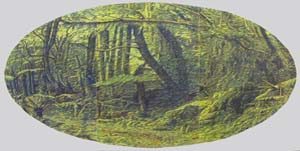Sasson explores the way in which a photographic and digital landscape panorama can deconstruct back into the language of painting and drawing, operating in two ways: on the one hand he strives to obtain maximum illusive accuracy of painting that applies the laws of perspective, and to create a reliable three-dimensional space based on the classic perception of painting as “a window into reality”; on the other hand, he applies the technique of anamorphosis which distorts the image, enabling its perception only from a specific point of view, or with the help of a cylindrical mirror placed on it. One of the best known examples of this technique is the painting The Ambassadors (1533) by German painter Hans Holbein the Younger. In his paintings executed in this technique Sasson uses a round or elliptical format, the point of view is extended beyond the possible, and the resulting landscapes appear distorted and unreal. In order to create the deformed landscape image Sasson is aided by a computer application which transforms the image according to the anamorphosis perspective.
The color scale in the paintings is restricted, using changing hues of green combined with purple and yellow, thus producing a photographic-digital effect. The colors are typified by a phosphorous quality that lends the forests a mysterious, unrealistic appearance. The landscapes in the paintings appear somewhat threatening. Even when Sasson paints according to the scientific laws of perspective, a sense of claustrophobia and disorientation is generated in the painterly sphere, as the forest engulfs the viewer, closing in on him.
Less Reading...
